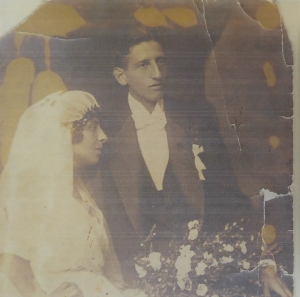Dining and Photography
The Intersection Between Dining and Photography
January 18 – February 9, 2025
Opening Reception January 18, 2025, 5 – 9 pm
This small exhibition has been curated in synergy with the opening of the Center for Photography Woodstock in Kingston on January 18, 2025. The close proximity of IMoDD, the Holocenter, and the CPW create a “Museum Row” concept, linking kindred spirits in terms of exhibitions, educational programming and the celebration of the arts in Midtown Kingston New York.
The International Museum of Dinnerware Design is open Thursday – Sunday noon-5 p.m. Members enjoy free admission. Non-members admission is $10. IMoDD will additionally be open from 5 – 8 p.m. on Saturday, January 18 for the opening of this exhibition.
It has been said that one “eats with one’s eyes.” The implication is that one can anticipate how food will taste based on how it looks and how it is presented. A food photographer might have insights into this and other dining tropes. But what is the intersection between photography and dinnerware when it comes to such well-known photographers as Sandy Skoglund, Piero Fornasetti, Robert Mapplethorpe, Cindy Sherman and others who might not all be household names?
This exhibit looks at photography as it relates to dinnerware and dining. Three approaches are explored through objects in the IMoDD collection. First, photography as social commentary on popular culture is seen in Sandy Skoglund’s The Cocktail Party, a large-scale photograph created from the artist’s installation of human figures and inanimate living room furnishings covered with Cheez Doodles. In addition, work by Fornasetti, Mapplethorpe and Cindy Sherman alter both the traditional presentation of images by applying them to dinnerware, and the functionality of the dinnerware through the application of images. And finally photographic methods that physically alter the ceramic or glass structure of the dinnerware to create images through the interplay of light with the material using lithophanes or photosensitive glass.
Sandy Skoglund
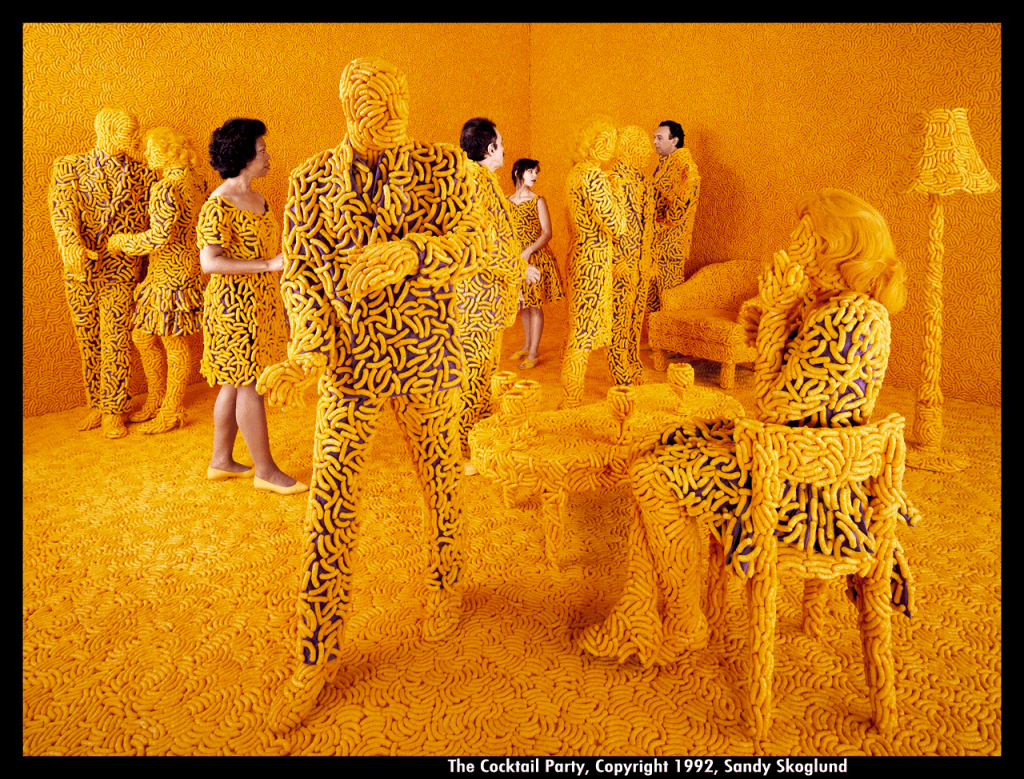
The Cocktail Party © 1992 Sandy Skoglund HC 2/4
archival photograph, 48×65”(121.9×165.1cm)
IMoDD 2013.132 Gift of Margaret Carney and Bill Walker
Sandy Skoglund’s large archival photograph, The Cocktail Party (1992) was one of the first significant artworks acquired for the International Museum of Dinnerware Design after its establishment in 2012. Curator Margaret Carney had the idea that this unique museum that celebrates all aspects of dining should not be limited in its collections to functional dinnerware, and therefore should acquire fine art that references dining. An admirer of Sandy Skoglund’s art, Carney believed that museums and private collections could be judged on the basis of whether they owned installations or Cibachrome prints by Sandy Skoglund. She often cites the Skoglund installations and/or photographs at the Denver Art Museum (Fox Games), the McNay Art Museum (The Cocktail Party), and the J. Paul Getty Museum Collection (Revenge of the Goldfish), as examples of exemplary art museums. The Cocktail Party archival photograph in the IMoDD collection is approximately 48” x 65” and was donated by Margaret Carney and Bill Walker in 2013 (IMoDD 2013.132).
Sandy Skoglund (American, b. 1946) is a photographer and installation artist whose contributions to photography have advanced the medium as a form of conceptual art. She often creates compositions by building elaborate sets or tableaux, later photographing them. She frequently uses food and animals in these installations. She has said “I think of food as a universal language. Everyone eats. For the camera, food has colors and textures that can be manipulated to fabulous effect.” The Cheez Doodles in The Cocktail Party are used as a raw artistic material. While appearing playful, the artist employed an extensive amount of popular snack food to create a fantastical scene that addresses popular culture and history. The Cheez Doodles are preserved in epoxy resin and affixed to human models and inanimate living room objects to create rich textural surfaces in a palette of mostly orange, but with glimpses of purple to create a complimentary color relationship. The installation has been described as “a witty commentary on the artificial nature of certain social gatherings.”
Piero Fornasetti
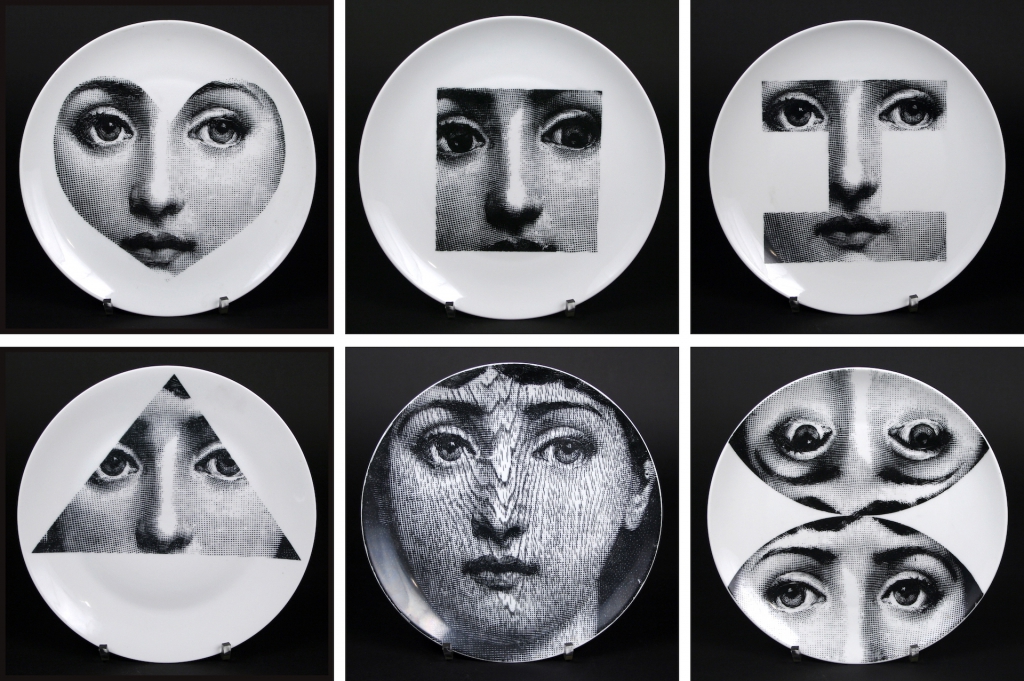
6 plates, Tema e Variazioni (theme and variation) series No. 41, ca. 1960s (Lina’s face in a heart), No. 49 (or 45), ca. 1960s (Lina’s face in a square), No. 66, ca. 1960s (Lina’s face in an “I”), No. 70, ca. 1960s (Lina’s face in a triangle), No. 90, ca. 1960s (Lina’s full face plate with woodgrain texture), No. 246, ca. 1960s (Lina’s face in two semi-circles)
porcelain, glazed and decorated with photographic image
IMoDD 2014.215-2014.220, Gifts of Kathleen Collins
In the case of Piero Fornasetti, IMoDD owns 6 of the plates from his Tema e Variazioni (Theme and Variations) series which includes more than 350 variations on the enigmatic face of the early 20th century opera singer Lina Cavalieri. The original marketing brochure elaborates on these images. Fornasetti himself explained that “Lina Cavalieri’s face was an archetype – a quintessentially beautiful and classic image, like a Greek statue, enigmatic like the ‘Gioconda’ and therefore able to take shape into the idea that was slowly building in his mind. It was this formal, graphic appeal (rather than Lina Cavalieri’s celebrity) that demanded such loyality and inspired the spontaneous and ceaseless creativity of Fornasetti. For him, this face became the ultimate enduring motif. With great modesty all these works were reproduced on a series of everyday objects like the plate. Tema e Variazioni shows its variations playing with one idea.”
There has been extensive writing about what it means to use a “blank” plate as a canvas for a work of art. A recent article in the October 2024 Apollo magazine, “Plate Expectations,” by Molly Pepper Steemson, covers this topic brilliantly. The plate designers or decorators could be Roy Lichtenstein, Picasso, Dali, Matisse, Warhol, Miró and on and on. The main point being is the artist choosing the plate format because it loosens the restrictions connected with the expectations of art on canvas. The International Museum of Dinnerware Design enjoys “plates” as functional works of art as well as plates as the canvas for fine art, including work by Lichtenstein, Picasso, Fornasetti, and photographer Robert Mapplethorpe, to name just a few.
Robert Mapplethorpe / Swid Powell
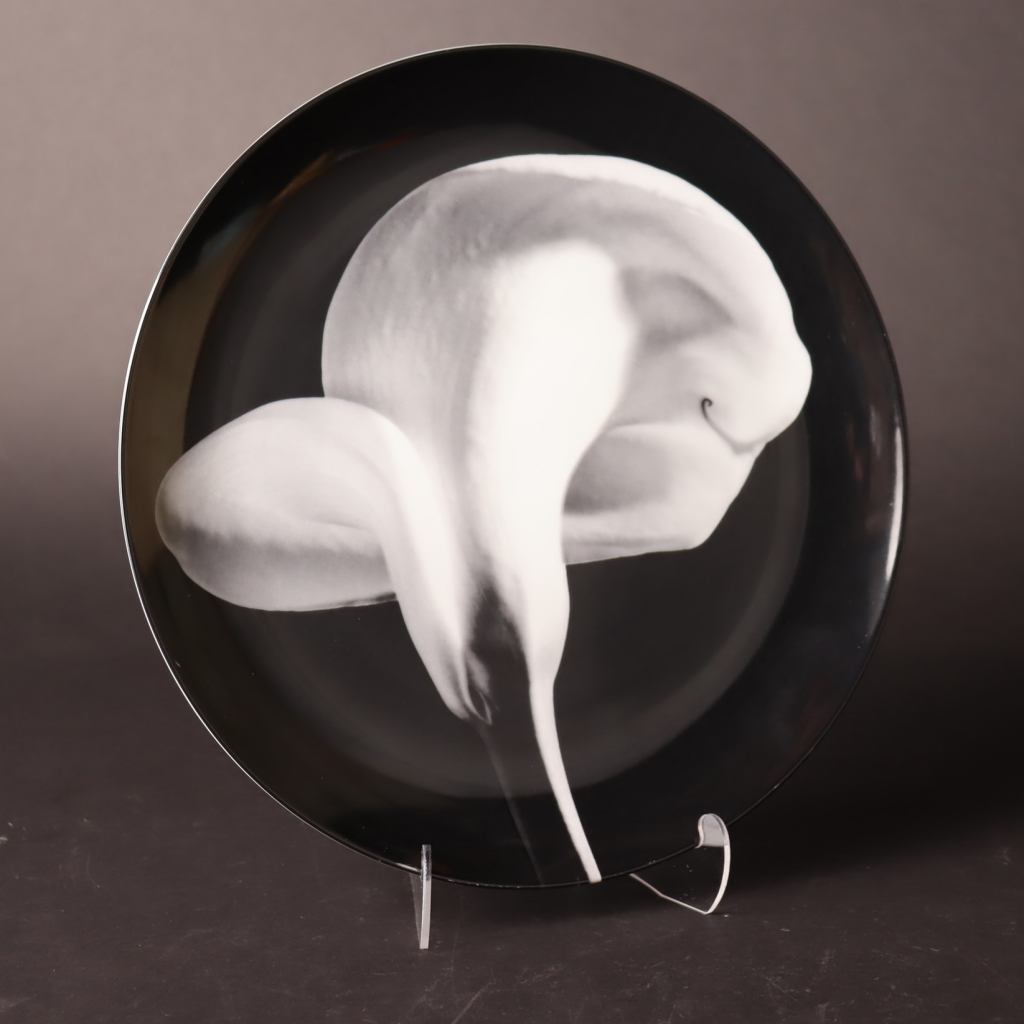
Robert Mapplethorpe (1946-1989)
Calla Lily photographic image on porcelain service plate, 1984
porcelain, glazed, with overglaze transfer printed photographic image
Diam: 12”
mark: overglaze “Swid Powell © Robert Mapplethorpe ‘Calla Lily, 1984’”
IMoDD 2024.103 Gift of Richard W. Gold from the Collection of Arthur J. Williams
The lone Robert Mapplethorpe (1946-1989) plate with his iconic Calla Lily photographic image from 1984 was the gift of Richard W. Gold from the Collection of Arthur J. Williams. It’s a 12” porcelain service plate. No knife or fork was intended to ever be scraped across its shiny surface. The image is overglaze transfer printed and the manufacturer was Swid Powell, New York, New York (1982-2001). There is a similar piece in the collection of the Brooklyn Museum, that was donated by Swid Powell, the manufacturer.
Swid Powell was a New York City-based tableware company that produced some of the most distinctive china, glass, and silver of the 1980s in collaboration with international architects and designers. Swid Powell was established in 1982 by Nan Swid and Addie Powell, who met while working at the modernist furniture company Knoll International. It has been written that they wished to “translate the aesthetics of postmodern design from the skyscraper to the dining table.” Their early discussions involved Philip Johnson, Stanley Tigerman and Richard Meier. Collaborators included Zaha Hadid, Robert Venturi, Elsa Rady, Peter Eisenman, Robert Mapplethorpe, Frank Gehry, and Michael Graves, to name a few.
Cindy Sherman
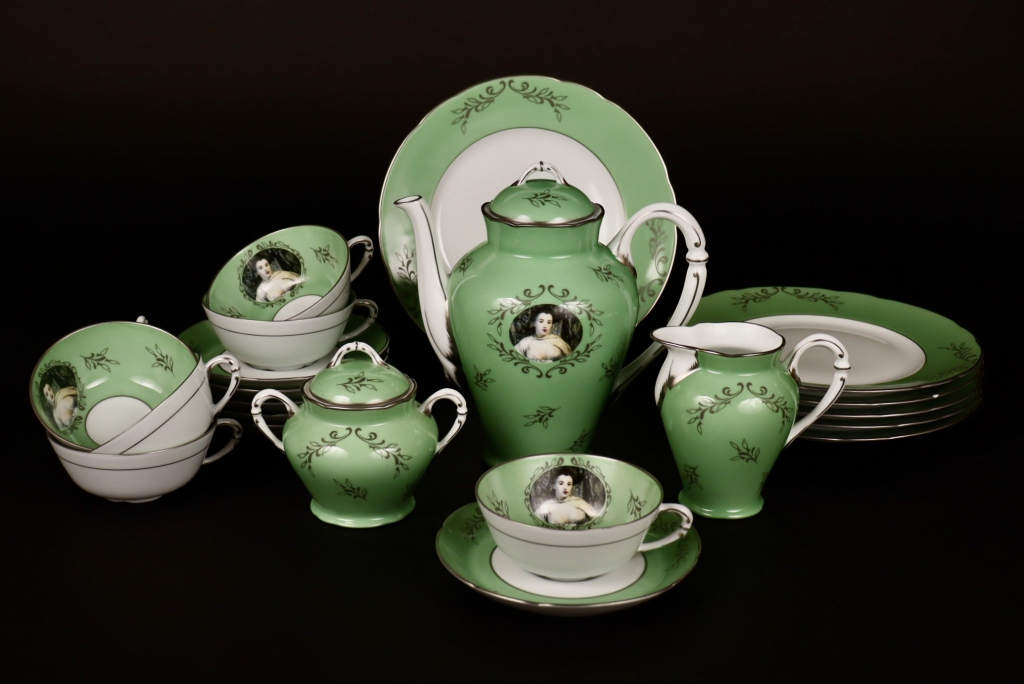
Ancienne Manufacture Royale, Limoges, France (established 1737)
Madame de Pompadour (nee Poisson) Tea Service, in green with images of Cindy Sherman as Madame de Pompadour, 1990
glazed porcelain with photoscreenprint, platinum and enamel decoration
marked “Artes Magnus 1 V 75”
IMoDD 2023.105 Museum Purchase

Cindy Sherman (American, b. 1954)
Madame de Pompadour (nee Poisson) Tea Service, in green
If standard porcelain dinner plates and service plates can be the canvases for the fine art photography of Robert Mapplethorpe and Piero Fornasetti, then these formats seem almost tame when compared to the photographer Cindy Sherman (American, b. 1954) placing her photographic image of herself as Madame de Pompadour on a Limoges tea service designed to mimic the original tea service commissioned by Madame de Pompadour in 1756 at the Manufacture Royal de Sèvres. The photo process used is complex, requiring up to 16 photo silkscreens. The pieces were silk screened and painted at Ancienne Manufacture Royale in Limoges, fired on four different occasions and then individually signed and numbered. The Madame de Pompadour (nee Poisson) Tea Service in green was manufactured in 1990 and marked Artes Magnus in a limited edition of 75. IMoDD acquired the set at auction in 2023 (IMoDD 2023.105). It is comprised of a teapot, milk pitcher, covered sugar, six teacups and six saucers, and six dessert plates.
Cindy Sherman is best known as an artist who creates photographic self-portraits, depicting herself in many different contexts and as various historic and imagined characters. When she shoots these types of series, she assumes multiple roles as author, director, makeup artist, hairstylist, wardrobe mistress and model. She has written, “I’m trying to erase myself more than identifying myself or reveal myself. That’s a big confusing thing that people have with my work: they think I’m trying to reveal these secret fantasies or something. It’s really about obliterating myself within these characters.”
Ted Reyda / Corning, Inc.
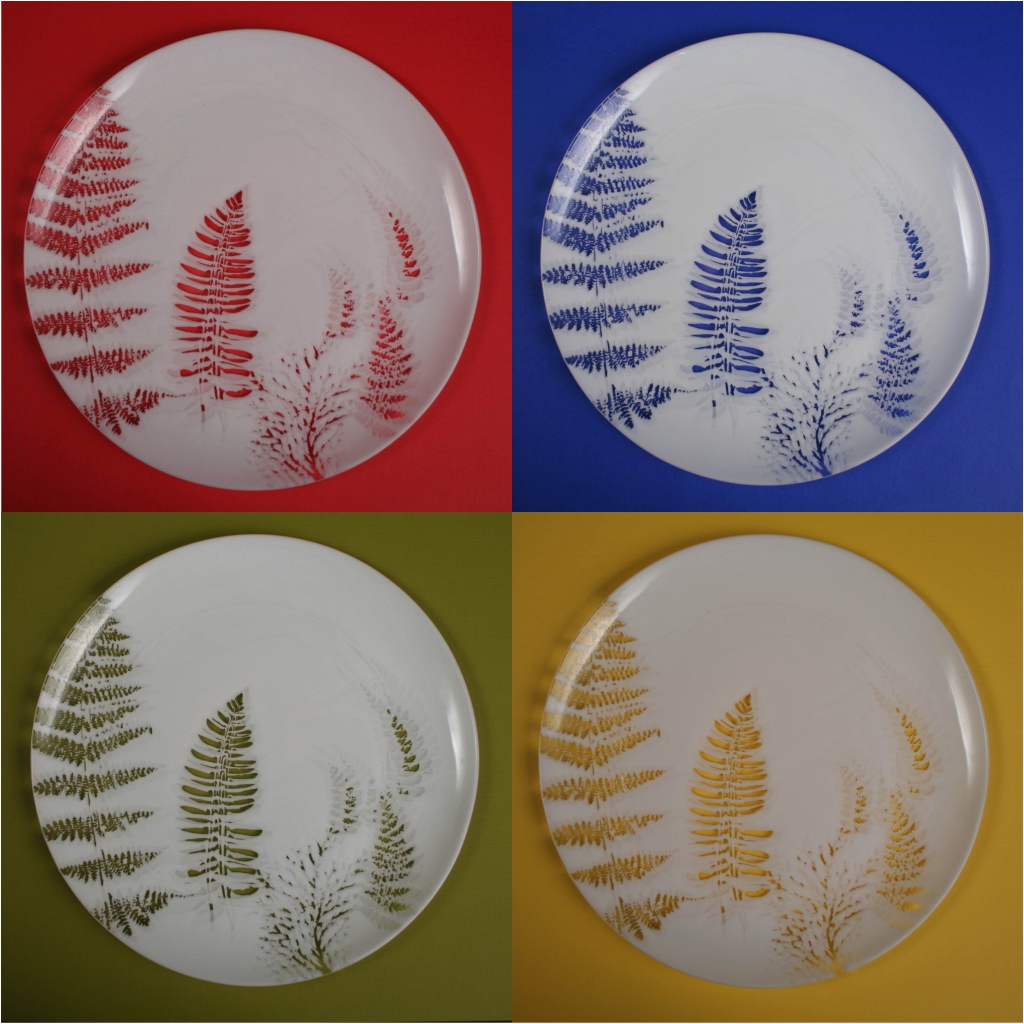
Ted Reyda, designer (American, b. 1943)
prototype photosensitive glass plate with fern motif shown with different table surfaces, 1971
glass
On loan from the designer
There is a prototype glass plate in the IMoDD collection which was created using a proprietary photosensitive glass process in 1971 by designer Ted Reyda (American, b. 1943) when he was working at Corning, Inc. By exposing the photosensitive glass to light during processing, portions of the plate are made permanently transparent and other portions opaque. In this prototype, a transparent fern motif with an opaque white background was created. Although this is a genius idea, it never went into production because it was cost prohibitive. The beauty of this singular plate design is that one would never need to purchase another set of dishes because each time the background (or table surface) is altered, the plate is magically transformed into something different.
Future Retrieval / Katie Parker and Guy Michael Davis
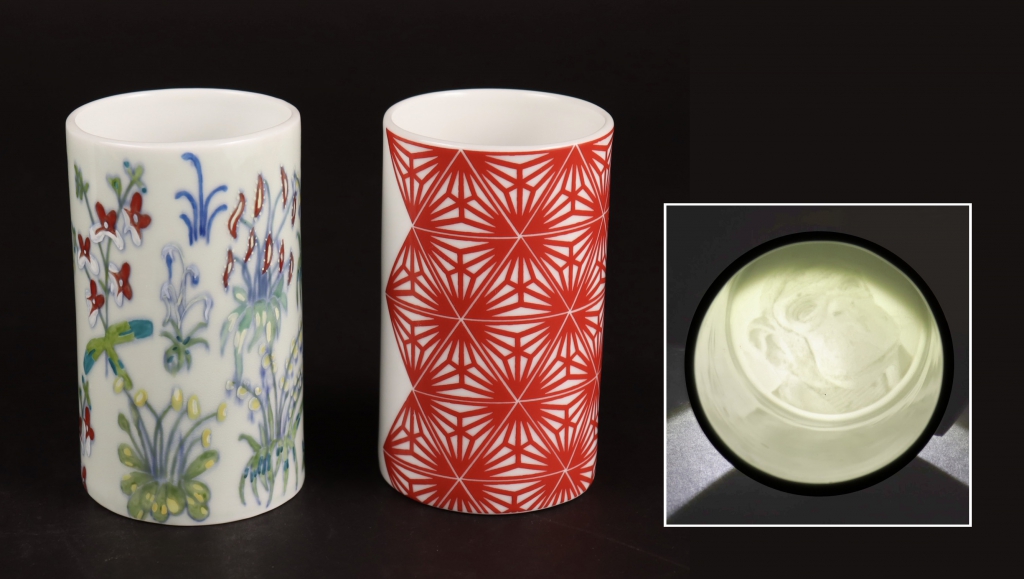
Katie Parker (American, b. 1981) and Guy Michael Davis (American, b. 1979)
cylindrical tumblers geometric and floral design motifs with monkey lithophanes, 2012
porcelain, china paint, and underglaze transfers
H: 5” Diam: 3”
2012.22, 2012.23 Gift of the Artists
Lithophanes are carved porcelain plaques that when illuminated from the back, cause an image to magically appear as clean and crisp as an etching or mezzotint. Created in the 1800s in China and then in Europe, hundreds of thousands were created in factories in Germany and France in the 19th century, before electricity was common. These plaques were incorporated into window designs, teacups, fireplace screens, and everyday household objects. Some lithophanes were created utilizing photo process on porcelain. A few contemporary ceramic artists have played with this concept of lithophanes. In 2012, when artists Katie Parker and Guy Michael Davis were artists in residence in Jingdezhen in China, they took along some experimental lithophanes they had created in the U.S. These were cup bottoms, with images of Chairman Mao and also a monkey. While in China, these were fashioned into beautiful tumblers where a lithophane was revealed at the bottom of the cup when the glass was drained.
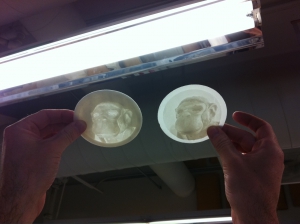
The process of making the lithophane started with a photograph. Photoshop was used to set the levels digitally before 3D printing so when cast in clay the black would be the thickest part of the image and the white would be the thinnest. Then the image of the monkey in a circle was printed in 3D using a powder bed, a rubber mold was made from the 3D print, and then cast in plaster to make a mold for forming the clay. A bottomless tumbler was designed that would fit onto the image and each cup was assembled while the clay was still wet.
Bryan Czibetz

tumbler with a lithophane of an X-ray image of a bound foot, ca. 2005
porcelain
The image on the right shows the piece illuminated from the inside
Artist Bryan Czibesz used a similar photographic technique to incorporate an x-ray of a Chinese bound foot (sans bound foot shoe) into a classic porcelain conical tumbler. To produce these lithophanes Czibesz used a process that generated a low relief 3D model from an image, then digitally carved it in plaster. This resulted in a mold, into which he hand-pressed a translucent porcelain.
Czibesz writes, “I am fascinated by this brutal practice of deliberately impairing a woman’s ability to be mobile, which I see as a kind of anti-prosthetic one. I obtained this image from the Library of Congress Frank and Frances Carpenter Collection, where it estimates its origin from between 1890 and 1923. It currently can be found here https://www.loc.gov/item/91787056/. The inclusion of the foot-binding X-ray in this collection aligns with the Carpenters’ interest in documenting cultural practices around the world. They likely acquired or had access to this material during their travels or through collaborations with institutions or professionals studying the practice, in particular ones involved in public health, who may have commissioned or documented such X-rays for educational purposes.”
The IMoDD collections contain other works that demonstrate the intersection between dining and photography. Because of our recent relocation from Ann Arbor, Michigan to Kingston, New York, the majority of the collections have not yet been unpacked. As a teaser, here are a few images of indescribable installation involving a lot more than photography and dinnerware by the artist Rae Stern. Stay tuned for more to come at a later date.

Lotti Halpern Vignette: Again and Again, 2019
unglazed porcelain with unglazed translucent porcelain lithophane, arduino operated digital components, LED light, rechargeable lithium-ion batteries, 3-D printed TPU filament
2020.90 Gift of an Anonymous Donor
photo by T. Maxwell Wagner
